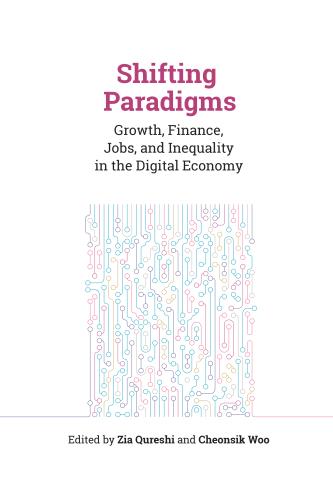This year’s financial inclusion week, focused on “Keeping Clients First in a Digital World,” enabled stakeholders around the world to explore salient questions surrounding the topic of advancing access to and usage of quality, affordable financial services among those who seek to use them. In this post, we explore several applications of digital technology for advancing inclusive finance and highlight four priority areas for “keeping clients first” in a rapidly evolving global financial ecosystem.
The theme of customer centricity with respect to digital finance is highly relevant to the Brookings Financial and Digital Inclusion Project (FDIP), which assesses country commitment to and progress toward engagement with digital and traditional financial services by underserved individuals. The 2015 and 2016 FDIP reports examined financial inclusion initiatives and financial service adoption rates across a geographically, politically, and economically diverse set of countries.
Both reports yielded good news regarding the global financial inclusion landscape: Many countries from across geographic and income spectrums are prioritizing financial inclusion as a national policy objective and are making progress toward their financial inclusion goals. Digital financial services have helped broaden and deepen engagement with financial services: For example, in countries such as Kenya and Rwanda, the proliferation of mobile phones and other digital tools have contributed to significant increases in financial inclusion.
Among other advantages, digital financial services can facilitate greater privacy for customers, reduce the likelihood of theft and leakages, enable lower costs for providers, and enhance affordability and convenience for customers. Digital technologies can also help individuals build credit histories by offering a wider range of tools aggregating and analyzing data, facilitating access to credit and other services among underserved customers.
The potential impact of digital finance on a global scale is considerable: A September 2016 report by the McKinsey Global Institute estimated that “widespread adoption and use of digital finance could increase the GDP of all emerging economies by 6 percent, or $3.7 trillion, by 2025.” Yet while digital financial services have captured the interest of stakeholders across the financial inclusion landscape, engagement with digital finance remains uneven across countries and demographic groups.
To facilitate the adoption of financial tools that meet the needs of underserved customers, policymakers, regulators, financial service providers, and other stakeholders should work together to advance four key principles:
1. Accessibility
As noted in the 2016 Brookings financial inclusion report, digital mechanisms can help mitigate one of the barriers to financial inclusion—specifically, a lack of access to documentation required to open a financial account and engage with formal financial services. For example, digital identity mechanisms provide opportunities to address the global gender gap in financial inclusion, as women in developing economies are less likely than men to have the formal identification relevant to account opening processes. Additionally, digital financial services such as mobile money are helping to extend financial access into underserved areas.
2. Affordability
According to the 2014 Global Financial Inclusion (Global Findex) database, about 24 percent of men and 23 percent of women without accounts at a financial institution cited the cost of accounts as one of the reasons they had not opened an account. Yet while this finding suggests that affordability is a key component of promoting engagement with the formal financial ecosystem, data surrounding the pricing of digital products and services—as well as the costs associated with digital delivery channels (e.g., mobile phones)—are limited across countries.
Greater availability of data surrounding these indicators would better enable researchers, government entities, financial service providers, and other stakeholders to develop strategies to advance access to affordable financial services among underserved customers and target those strategies appropriately.
3. Utility
While facilitating the availability and affordability of financial services are key components of advancing financial inclusion, these criteria alone are not sufficient. Customers must also be able to leverage financial products and services in a way that ultimately promotes their financial health.
Facilitating usage of digital financial services is particularly challenging in areas where the digital ecosystem is not fully developed. For example, connectivity and liquidity issues and lack of acceptance of digital financial products among merchants can impede the adoption of formal financial services. Enabling merchants to explore digital payments at low or no cost, investing in digital infrastructure, and digitizing government-to-person payments can serve as incentives and conduits for strengthening the digital ecosystem.
Even where digital financial channels are fairly well-established, it is crucial to assess and clearly communicate the value those services might yield for various market segments. A recent report from the Center for Financial Inclusion at Accion highlights the importance of product design, consumer awareness, confidence in the financial system, and effective product delivery in helping ensure that customers are well-positioned to optimize their engagement with electronic payments.
4. Security
The issue of cybersecurity is a salient and arguably underexplored dimension of the shift toward digital financial services. One of the key concerns in the fintech space is that advances in connectivity are outpacing security. At the consumer level, investments in financial literacy can help mitigate some security concerns. From a policy and supply-side perspective, financial service providers (both traditional entities and fintech startups) and regulators must engage in ongoing dialogue to ensure adequate consumer protection and technical safeguards are in place.
The Brookings Institution is committed to quality, independence, and impact.
We are supported by a diverse array of funders. In line with our values and policies, each Brookings publication represents the sole views of its author(s).













Commentary
Financial inclusion week 2016: Prioritizing customers in the digital ecosystem
October 31, 2016